Socket with built-in RCD: device, connection diagram, recommendations for selection and installation
Residual current circuit breakers have recently come into wide use, due to the increased number of household appliances. But not always the tenants have a desire to connect the entire apartment to this equipment because of a possible false alarm.
That is why the usual socket with an RCD is popular, into which you can connect only one potentially dangerous device: a washing machine, shower, dishwasher. You will learn all about the principle of operation, design features and types of protection devices from our article. We have valuable installation tips.
The content of the article:
The relevance of power sockets with RCD
More than 40% of fires occur due to faulty wiring, thousands of people per year die at home from electric shock. These sad cases could not have happened if the electric circuit were controlled RCD - residual current device.
This device monitors the difference between zero and phase currents, and if they differ significantly, it turns off the power to the load.
The current threshold for not releasing the wire by human muscles is 10 mA, therefore, an outlet with an RCD must provide a clear definition of its level and the operation of the protection. The automation of the device is designed in such a way that when you touch a bare wire under voltage, a person does not even have time to feel an electric shock - the device turns off the power almost instantly.
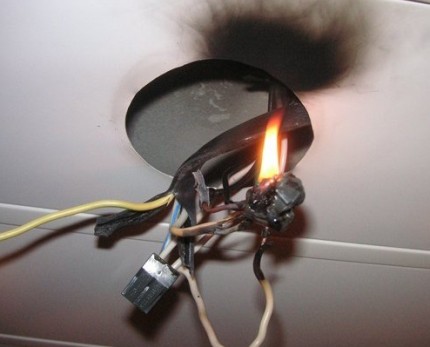
Breakdown of faulty wiring inside the walls can be invisible for a long time and not lead to a fire hazard. But over time, the insulation of the wire becomes thinner and the current increases, which can cause a fire.An RCD determines the problem long before the cable is heated and disconnects it from the network.
With a hidden breakdown of insulation inside the walls, the user's wallet also suffers. After all, in fact, electricity is spent on heating concrete slabs and plasters. therefore RCD installation is a great way to increase the electrical safety of housing and its residents, as well as prevent unnecessary costs of paying for light.
Internal circuitry of the device
The residual current device is based on a differential transformer, which is a toroidal core with windings. It is he who is responsible for determining the leakage current, the occurrence of which leads to the operation of the electromagnetic relay.
Active load disconnection should occur in a maximum of 30 ms, although there are models that are designed for a threshold value of 10 ms.
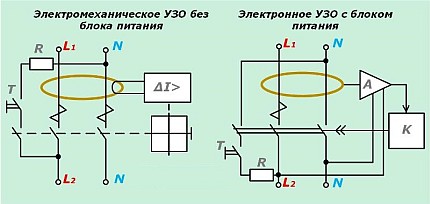
The UZO device for the outlet has a special design that allows all equipment to fit in standard socket. The miniaturization of the components also affects the cost: when purchasing the components of the device separately, their price will be at least three times lower.
Possible construction options
In a combination of an outlet and an RCD, both devices are equivalent. It is difficult to determine the primary role of any of them. Therefore, externally they can be a socket with an RCD or an RCD with a socket.
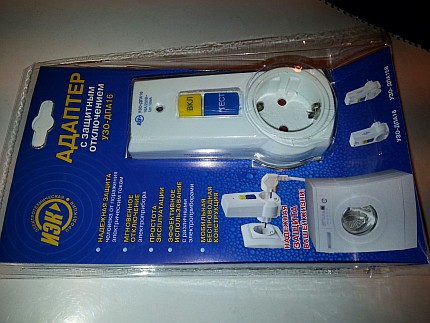
The design of these devices may be as follows:
- module embedded in the socket;
- monoblock adapter plugged into a simple outlet;
- DIN rail mounted module.
In fact, these devices are two independent devices connected in a single design. Their functionality is the same, therefore, the main selection criterion is the convenience of a particular model in a particular situation.
Schemes for connecting sockets with RCD
Ways to connect outlets with a built-in RCD can be different. They depend on the number of connected devices, the location of the wires and the presence of the ground bus. It is important to connect the sockets in the house so as to ensure maximum safety of residents and comply with all electrical standards.
The only outlet with grounding
The simplest scheme for embedding an outlet with an RCD in a home electrical network includes only one device. Not only phase and zero are suitable for it, but also the ground wire. Such a scheme allows for double protection of a person.

Grounding serves as a passive way to protect a person from electric shock by contact with a live appliance. In this case, the main stream of electrons goes into the earth, but a person is still in danger. A protective shutdown device eliminates almost all health risks in the above situation.
Main advantage grounding circuits It is possible for the current to flow smoothly into the ground, which will lead to the instantaneous operation of the RCD. In the absence of such a leak, the conductor will be a person who is in contact with the surface under voltage. This may result in a sensitive electric shock.
System for connecting a socket through a difavtomat
A two-level system of RCDs and a differential machine is optimal from the point of view of convenience. General differential automaton provides additional protection for the entire apartment not only against leakage current, but also from network overloads and short circuits.This scheme is recommended for use in residential premises with highly branched wiring.
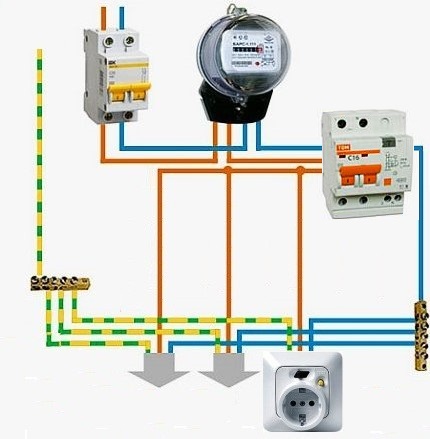
When the electrical mechanism of the outlet is triggered, it will turn off without disconnecting the entire apartment, while the remaining rooms will remain under backup protection.
A differential automatic machine can have the same threshold current as an outlet with an RCD, or maybe more (100 mA). With its identical value, both devices connected in series can be knocked out simultaneously. The advantages of connecting the outlet to ground remain the same as in the previous circuit without a difavtomat.
Single-level multiple outlet system
When connecting to the network of several outlets with an RCD, the principle of their operation does not change. Each device ensures the safety of the use of household appliances connected to it.

Such a circuit is mounted quite simply and does not require common difiltomat settings or RCD. The advantages of grounding remain the same as in the previous options considered.
Differences in operating principles RCD and differential automaton are given in the article, the contents of which we recommend to read.
The only drawback of a system of several outlets is their cost, because for each device you will have to pay a considerable price. An alternative to this option is to install one RCD on the entire premises.
Not recommended circuit without grounding
The circuit diagram for connecting sockets with RCDs in the absence of grounding is almost the same as the two-level and single-level options proposed above. The difference is only in the absence of a wire, which provides the removal of current from the housing of a household appliance in case of damage to its electrical insulation.
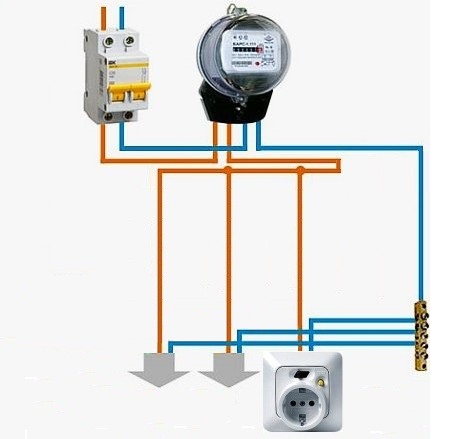
In fact, the vast majority of houses and high-rise buildings were not equipped with grounding before 2000, so this connection scheme is the most common. However, there is a hidden danger in it - the lack of contact of the housing of the household appliance with the “ground”.
This fact is not only a problem for human health, but also has a negative impact on the performance of microcircuits in household appliances. Therefore, the presence of a grounding bus in home wiring is extremely necessary and desirable.
Characteristics of sockets with RCD
Modern sockets with RCDs are not installed in every apartment. The reason for this is the predominant mounting of these devices or difavtomatov at the common entrance of the wires into the living room.
To determine the best option for arranging electrical protection at home, you need to familiarize yourself with the pros and cons of sockets with RCDs.
Benefits of Combined Devices
2-in-1 current leakage protection devices are not often used, but they have a number of advantages, due to which they are indispensable in some cases.
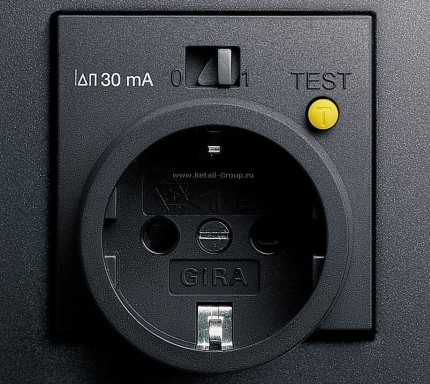
The advantages of sockets with RCD include such qualities as:
- guaranteed blocking of electric shock in the presence of leakage;
- lack of need for additional wiring or the purchase of an expensive general high-power difiltomat;
- universality in networks with various voltage;
- the ability to plug in any household appliances up to 3 kW;
- performance monitoring using a special testing button;
- the possibility of operation at a leakage current of 10 mA;
- protection against damage to the neutral wire;
- ease of installation;
- compactness;
- the presence of a voltage indicator in a conspicuous place.
The listed advantages of sockets with RCDs make them indispensable if you want to quickly provide additional protection against leakage current. In addition, these devices are quite mobile and can always be moved to another place within a few minutes.
Disadvantages of combining sockets and RCDs
Outlets with RCDs and similar portable devices are sold not so much. The reason for this is a number of their shortcomings, which force consumers to choose other devices.
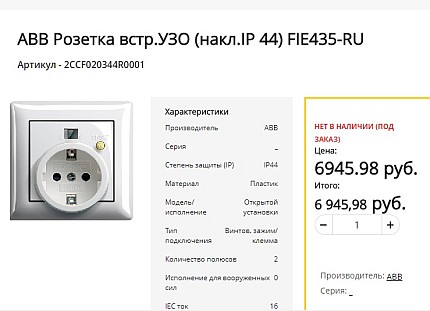
The disadvantages of protective outlets include:
- High cost. It is much easier to install one RCD on the entire apartment or on a group of rooms than to mount a separate device in each outlet.
- The presence of competitive devices in the form of difavtomatov, which also provide additional protection in the presence of network congestion or shorted wires.
- Frequent false alarms, especially in older homes with spoiled wire insulation.
- Many models require deep sockets, which complicates their installation.
Thus, sockets with RCDs are a rather highly specialized product. It is used only when there is no desire or ability to install common diflift machines in the apartment, or there is a need for protection with a threshold level of 10 mA.
Network Connection Rules
Connecting an embedded outlet with an RCD to the network is quite simple.
The maximum list of actions for this may look as follows:
- Select a suitable socket for the device.
- Drill a hole in the wall with a crown and bring to it the phase, zero and ground (if any).
- Turn off the power.
- Connect the electrical wires to the corresponding terminals on the outlet.
- Fix the device in the socket.
- Turn on electricity.
- Press the “Test” button and check the operability of the device. Normally, the power should be immediately turned off.
Installation of the device in the form of a monoblock adapter is not required at all. It is inserted into a simple outlet, and on the other hand, household appliances are connected to it.
To install the outlet from the RCD to the DIN-bar, you just need to fix it, attach the corresponding wires to the terminals and test. After that, the device is ready for operation.
Tips for choosing the right model
Choosing a suitable outlet with an RCD is simple, because manufacturers offer mostly standard solutions, and the range of these devices is small.
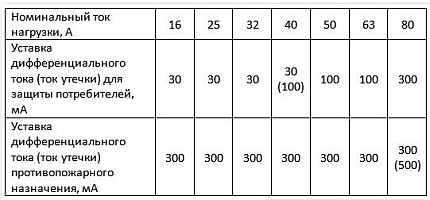
The main attention when buying should be paid to the following nuances:
- For bathrooms, the degree of protection should be at least IP44, and for dry rooms - IP21 or IP22.
- For modern household appliances, you can take devices with a residual current level of 10 mA, and when connecting old devices - 30 mA.
- If you plan to connect long wires or several household appliances to the outlet, it is recommended to use models with a leakage current of at least 30 mA.
- The maximum power of the connected equipment should not be higher than that indicated on the outlet. It is recommended that the allowable current be 30-50% higher than the real working one.
- The statistics of marriage and false positives are almost the same for most well-known brands, so you should not overpay for the name.
- For each device, unlike simple sockets, there must be a data sheet or an instruction manual with technical parameters.
If a socket adapter is purchased, then you can check its performance right in the store. It is enough to turn on its power supply and press the "Test" button, simulating a leakage of current.
After the purchase, you need to save the check so that in the event of a defect, you can exchange the device.
Conclusions and useful video on the topic
The principle of operation and the device of the RCD:
Demonstration of the socket adapter with an RCD:
The best option for electrical protection of residential premises is, of course, the installation of a two-level system of difavtomatov. However, such a scheme requires serious installation work and financial costs.
A compromise option, if necessary, to protect individual household appliances, is to buy a socket with built-in RCD. This device will help in time to determine the shock, turn off the power and save a person’s life.
Tell us how to install a socket with a built-in protection device with your own hands. Share only the well-known technological nuances that are useful to site visitors. Please leave comments, post photos, ask questions in the block below.

 Fire RCD: selection recommendations, rules and installation diagrams
Fire RCD: selection recommendations, rules and installation diagrams 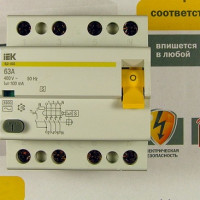 Selective RCD: device, purpose, scope + circuit and connection nuances
Selective RCD: device, purpose, scope + circuit and connection nuances 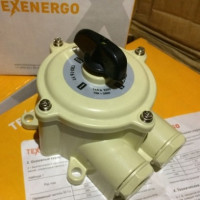 Batch switch: what is it and why is it needed + wiring diagram
Batch switch: what is it and why is it needed + wiring diagram 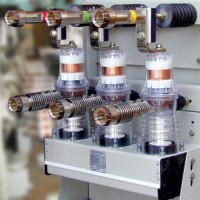 Vacuum switch: device and principle of operation + nuances of choice and connection
Vacuum switch: device and principle of operation + nuances of choice and connection  How to connect a differential machine: possible connection schemes + step-by-step instructions
How to connect a differential machine: possible connection schemes + step-by-step instructions 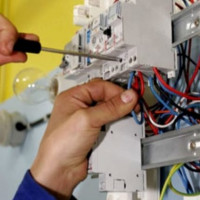 RCD for a water heater: selection criteria + schemes and connection rules
RCD for a water heater: selection criteria + schemes and connection rules  How much does it cost to connect gas to a private house: the price of organizing gas supply
How much does it cost to connect gas to a private house: the price of organizing gas supply  The best washing machines with dryer: model rating and customer tips
The best washing machines with dryer: model rating and customer tips  What is the color temperature of light and the nuances of choosing the temperature of the lamps to suit your needs
What is the color temperature of light and the nuances of choosing the temperature of the lamps to suit your needs  Replacement of a geyser in an apartment: replacement paperwork + basic norms and requirements
Replacement of a geyser in an apartment: replacement paperwork + basic norms and requirements